NVIDIA 680i: The Best Core 2 Chipset?
by Gary Key & Wesley Fink on November 8, 2006 4:45 AM EST- Posted in
- CPUs
NVIDIA Control Panel & nTune 5
One of most interesting features at the nForce 500 launch was the revamped control panel and nTune 5.0 performance applications. The Control Panel and nTune have undergone some fine tuning the past few months with version 5.05 launching for the nForce 600 and GeForce 8800 series of products shortly. NVIDIA has combined all of their various program applets into an integrated control panel to provide a common user interface. We found that this common interface makes it easier for a user to control the various functions of the board and video (NVIDIA based) from a central access point.
The new control panel offers configuration sections for 3D Settings for NVIDIA GPUs, Display settings, Networking options, Performance, System Stability testing, Storage, and Video/Television settings. The information contained in each section will already be familiar to those with nForce4 or nForce 500 boards but will include a few extended configuration options for the nForce 600 and GeForce 8800 products.
One noteworthy change with the GeForce 8800 series is that Coolbits no longer works for overclocking the GPU. The overclocking panel will still be visible in the legacy control panel but it will tell you to download nTune in order to overclock your GPU. The new GPU overclocking utility works in the same manner but is now integrated into the revised Control Panel.
One of the more interesting features for us is the Adjust Motherboard Settings application. We found the ability to dynamically write a significant number of performance settings directly to the BIOS without requiring a reboot a very quick and easy way to test or set overclocking options without exiting Windows. There are several third party applications that perform this same function but we believe the official support within the BIOS and nTune software gives it a significant advantage over the other solutions. The settings can be saved in a profile that can be loaded within Windows without having to reset the BIOS for individualized situations where settings for games might differ from those for audio/video playback. The system also allows for automatic or direct fan control on supported fan headers.
The Dynamic BIOS Access section offers the ability to change BIOS setting in five different categories that will take effect on reboot. The two sections not displayed are for power management and peripheral settings.
If you are not the type to enter the BIOS and tune your system or set it up for overclocking then NVIDIA offers an application that can do it for you based on your combination of components. We found the Coarse Tuning option would generally set up our system for a 6%~9% overclock of the FSB and memory along with a 3%~5% overclock on the GPU. The Fine Tuning option resulted in an 8%~15% overclock of the FSB and memory while the GPU usually increased 5%~8%.
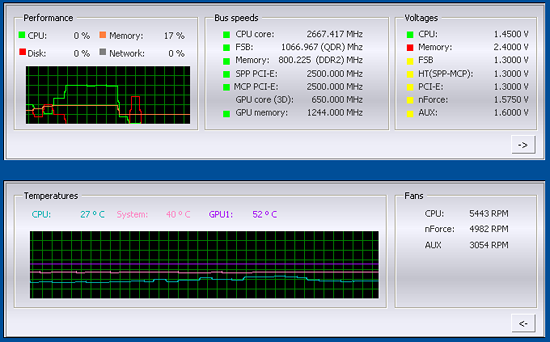
NVIDIA also includes a System Information utility along with a Windows based monitoring application. Overall, the polished look, feel, and operation of the new control panel along with the performance improvements offered in nTune 5.05 has raised the bar once again for user enhancements offered by the core logic suppliers.
One of most interesting features at the nForce 500 launch was the revamped control panel and nTune 5.0 performance applications. The Control Panel and nTune have undergone some fine tuning the past few months with version 5.05 launching for the nForce 600 and GeForce 8800 series of products shortly. NVIDIA has combined all of their various program applets into an integrated control panel to provide a common user interface. We found that this common interface makes it easier for a user to control the various functions of the board and video (NVIDIA based) from a central access point.
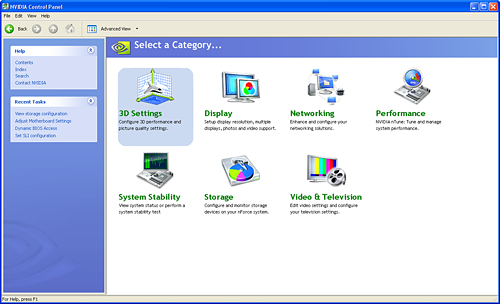 |
| Click to enlarge |
The new control panel offers configuration sections for 3D Settings for NVIDIA GPUs, Display settings, Networking options, Performance, System Stability testing, Storage, and Video/Television settings. The information contained in each section will already be familiar to those with nForce4 or nForce 500 boards but will include a few extended configuration options for the nForce 600 and GeForce 8800 products.
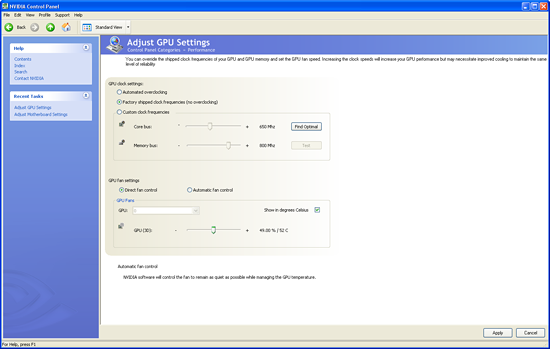 |
| Click to enlarge |
One noteworthy change with the GeForce 8800 series is that Coolbits no longer works for overclocking the GPU. The overclocking panel will still be visible in the legacy control panel but it will tell you to download nTune in order to overclock your GPU. The new GPU overclocking utility works in the same manner but is now integrated into the revised Control Panel.
 |
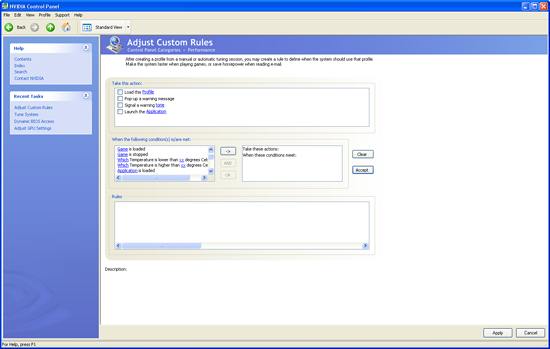 |
| Click to enlarge |
One of the more interesting features for us is the Adjust Motherboard Settings application. We found the ability to dynamically write a significant number of performance settings directly to the BIOS without requiring a reboot a very quick and easy way to test or set overclocking options without exiting Windows. There are several third party applications that perform this same function but we believe the official support within the BIOS and nTune software gives it a significant advantage over the other solutions. The settings can be saved in a profile that can be loaded within Windows without having to reset the BIOS for individualized situations where settings for games might differ from those for audio/video playback. The system also allows for automatic or direct fan control on supported fan headers.
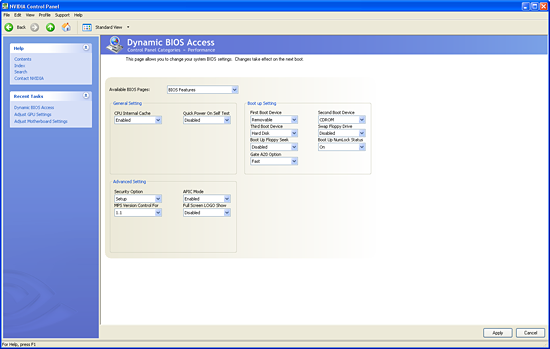 |
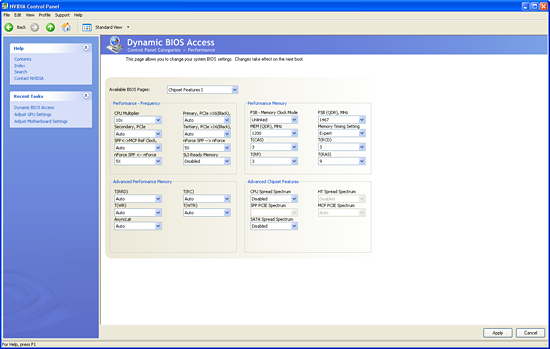 |
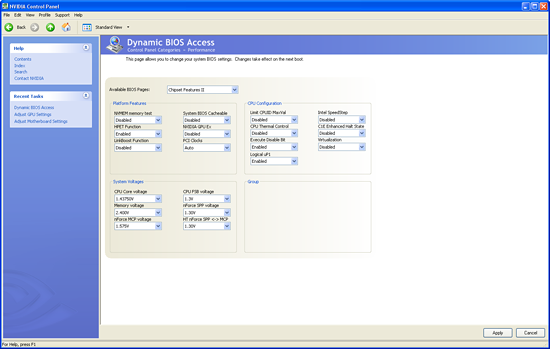 |
| Click to enlarge |
The Dynamic BIOS Access section offers the ability to change BIOS setting in five different categories that will take effect on reboot. The two sections not displayed are for power management and peripheral settings.
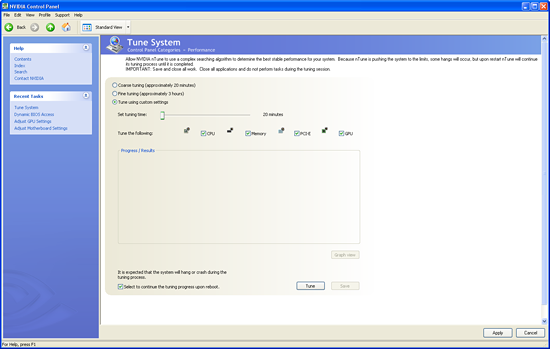 |
| Click to enlarge |
If you are not the type to enter the BIOS and tune your system or set it up for overclocking then NVIDIA offers an application that can do it for you based on your combination of components. We found the Coarse Tuning option would generally set up our system for a 6%~9% overclock of the FSB and memory along with a 3%~5% overclock on the GPU. The Fine Tuning option resulted in an 8%~15% overclock of the FSB and memory while the GPU usually increased 5%~8%.
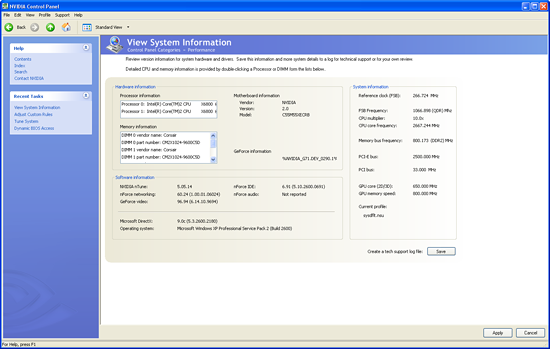 |
| Click to enlarge |

NVIDIA also includes a System Information utility along with a Windows based monitoring application. Overall, the polished look, feel, and operation of the new control panel along with the performance improvements offered in nTune 5.05 has raised the bar once again for user enhancements offered by the core logic suppliers.










60 Comments
View All Comments
fenacv - Tuesday, January 8, 2008 - link
http://www.pricebat.ca/EVGA-122-CK-NF67-T1-LGA-775...">http://www.pricebat.ca/EVGA-122-CK-NF67...-SLI-ATX...If you don't really care the prefermace, I found it's onsale just buy one only 138 bucks. It's cheap.
TheBeagle - Friday, December 8, 2006 - link
I'm wondering if these touted new 680i boards are vaporware, especially the Gigabyte GA-N680SLI-DQ6 board. Ever since you first alerted us to the fact that the 680i chipset was replacing the 590 version, I've been waiting to see this whole new array of motherboards. However, aside from a few boards (ASUS and a few others) the major board manufacturers haven't been forthcoming with these products. Maybe this is just going to be some sort of a big Christmas present that Santa delivers on the holiday. If you guys at AnandTech have some info on this, I'd sure like to hear about. Thanksmbf - Wednesday, November 29, 2006 - link
I, for one, am going to seriously miss the native hardware firewall of the nForce3 and nForce4 chipsets, so I'm anything but "thankful" for seeing it "jettisoned into deep space." Actually, this was one of the coolest features of the nForce chipsets and truly innovative.nVidia's stance as to removing it because the functionality is built into Windows Vista doesn't ring true. A software solution can never work as efficiently and transparently as a hardware solution. And what of the people having no intention to switch to Windows Vista, and there are many reasons for not wanting to. They're practically left out in the cold.
I second the opinion that nVidia probably botched the hardware in some form or other, although the hardware firewall works quite well on my nForce3 250gb based system, once you get familiar with its quirks. This actually doesn't bode well for nVidia's "inventiveness" and "forward-thinking" (think DualNet), since chances are nVidia will drop support completely rather than work out the bugs that inevitably will be there. Removing the hardware firewall is the best example of this.
Also, and this is a bit off-topic in regard to the rest of this topic, wasn't there supposed to be ECC memory support in the new northbridge for the 680i chipset? I remember reading about the northbridge also being used in the new nForce Pro series chipsets. Another feature that has been removed in the mean time?
skrewler2 - Monday, November 13, 2006 - link
How was the Tuniq Tower 120 on the board? I've heard lots of people complaining about backplates not fitting right on this board because the back of the mobo has lots of capacitors... Did you need to do any modding or did it just work?Gary Key - Monday, November 13, 2006 - link
I used the Scythe Infinity in my testing, Wes used the Tuniq. I did try the Tuniq and it was okay with an extra pad on the backplate that negated any damage to the capacitors.mlau - Monday, November 13, 2006 - link
Did you test a recent Linux kernel on this board?Which components are supported (I don't care about "raid"),
and how buggy are the HPET, (IO-)APIC and ACPI implementations?
Governator - Saturday, November 11, 2006 - link
First off, very well done article guys, but I've a question on the layouts with regards to PCI slots so far with the Asus and Evga; are we to expect similar layouts with upcoming boards from other manufacturers? I ask because I'm planning on a water cooled SLI setup upon a 680i and am planning on an X-Fi card but not sure if I'll be able to use the middle PCI slot, TIA...Gov
Gary Key - Sunday, November 12, 2006 - link
Most of the 680i boards have the same basic layout. On the Asus Striker board you should be able to use the X-FI with most watercooled SLI setups as an example. It will all depend on your setup but you can kiss the middle PCIe slot good-bye. ;)Governator - Saturday, November 18, 2006 - link
Hi Gary, sorry I meant to reply sooner but thanks for this. I'm hoping I'll be in good shape with the fact that I'll be using the new 8800GTX water block codeveloped by BFG Tech from Danger Den which appears that it'll only take up one slot allowing for that bottom PCI slot to go to the X-Fi card, thoughts? TIA ;)deathwalker - Friday, November 10, 2006 - link
I wonder if there are Matx mobo's in the future for the 600 series chipsets.